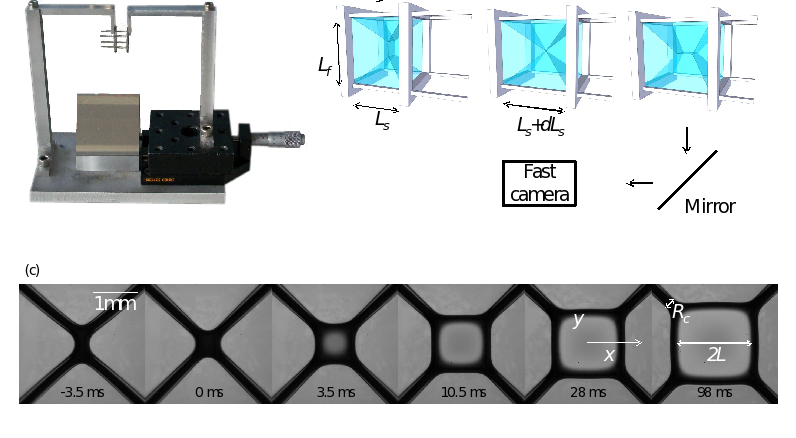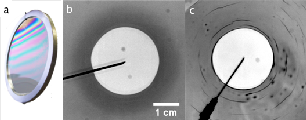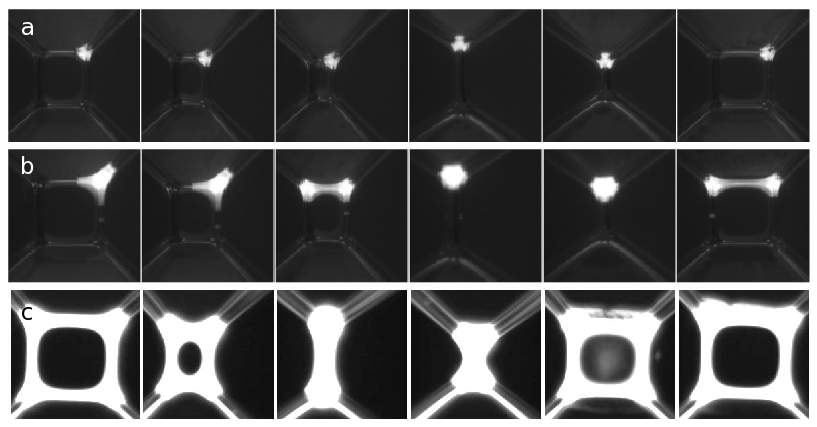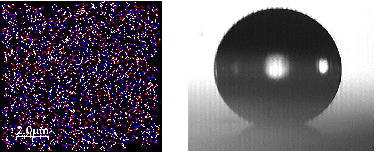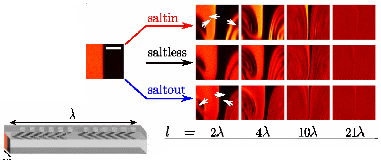More highlights...
|
Topological rearrangement in a soap film assemblyA specific soap film architecture has been designed to study the structure of the freshly formed film during a topological rearrangement. PIV, interferometric and absorption measurements allow to define two distinct mechanisms of soap film generation depending on the physicochemistry of the soap film solution. These results have large impat on the understanding of foam rheology. On the generation of a soap film during a topological rearrangement, Petit et al., Journal of Fluid Mechanics (2015) |
Set up used to mimick a topological rearrangement in a liquid foam. |
New Cassie-Wenzel dynamic transition upon drop impactYet another special dynamical behavior with Super-hydrophobic surfaces. Thanks to the nice textured surfaces developed by Choongyeop, we have identified a new regime during drop impact. This regime corresponds to a Cassie-Wentzel transition occurring during drop recoil. it is distinct from the water hammer mechanism, or from the pancake bouncing recently reported in the literature. Two types of Cassie-to-Wenzel wetting transitions..., Lee et al., Soft Matter (2015). |
Micro-textured pillar surfaces with varying solid fractions. |
Effect of low pressure on the contact line dynamicsWe experimentally investigate the influence of the surrounding pressure Ps on evaporation dynamics of drops on (super) hydrophobic surfaces. Main results:(i) the friction at the liquid-solid interface decreases linearly with Ps on hydrophobic surfaces;(ii) under lower pressures a “fakir” to Wenzel transition occurs quasi-instantaneously. The pressure variation appears as a powerful tool to modify in a controlled way the liquid-solid interface. Sessile drop evaporation on (super)hydrophobic surfaces, Kiper et al., Colloids and Surfaces A (2015) |
SEM image of a processed sample, snapshots of an evaporating drop and temporal evolution of contact angle and contact radius. |
"Cracks" in rigid soap filmsWe study the influence of the physico-chemistry of surfactants on soap film bursting dynamics, in order to understand its effect on liquid foam stability. With certain type of surfactants, the bursting dynamics deviates from the classical established law, providing a new method to measure the interfacial elasticity of the surfactant solutions. Besides, new "crack" patterns, similar to fractures in a solid membrane, are observed during the liquid film opening. Holes and cracks in rigid soap films, Petit et al., JFM Rapids (2015). |
(a) Soap film withdrawn from a liquid bath. (b) Opening hole in a film of colored soap. A darker i.e. thicker aureole is visible around the hole.(c) Bursting of a rigid soap film with visible « cracks ». |
Oil transport in a soap film architectureA specific soap film architecture has been used to study a fluorescent oil globule transport during a topological rearrangement in a soap film assembly. Depending on oil volume fraction, different regimes have been observed, including one where the transport is favored by the rearrangement process. Collaboration with E. Lorenceau IFFSTAR Oil repartition in a foam film architecture, Piroird et al., Soft Matter (2014) |
|
Drop impactsWe study the dynamics of drops impacting a solid surface. Using experimental tools that provide the local thickness and velocity of the liquid lamella, we compare impacts at room temperature with impact on a hot surface, where calefaction makes the liquid-substrate fraction negligible. Our approach allow us to evidence a viscous layer in the former case, and a purely convective flow in the latter. Bridging local to global dynamics of drop impact onto solid substrates, Lastakowski et al., Journal of Fluid Mechanics (2014) |
Impact of an ethanol drop on silicon wafer. (a) calefaction on a substrate maintained at 350°C, (b) on a cold substrate. |
Super-oléophobic surfaces We study experimentally the properties of oleophobic and super-oleophobic surfaces nanostructured with fractal patterns. In particular, we discuss the stability of the super-oleophobic regime, the mechanism underlying partial impregnation and the non-existence of homogeneous wetting. Superoleophobic behavior induced by nano- features on oleophilic surfaces. Ramos et al, Langmuir (2010) |
Hexadecane drop on a fractal super-oléophobic surface. |
Chaotic mixingWe explore the consequences of molecular effects on the macroscopic mixing properties of particles: in chaotic or turbulent flow. Even though diffusion phenomena amounts, ultimately, to mixing between strands generated by the flow, the influence of diffusion - and more generally molecular effects - have never been considered for this kind of phenomena. For the case of co-mixing of particles and a molecular solute (salt), we have shown the coupling mechanism - osmotic in nature - between those two passive tracers, and explore the macroscopic consequences. Boosting migration of large particles by solute contrasts. Abecassis et al. Nature Materials (2008).
|
Schematic of the chaotic mixer used (left) and experimental results for co-mixing of fluorescent particles: cross-section after various number of stretching-folding cycles: no co-solute (saltless), salt co-solute with the particles (saltin), or with the mixing solution (saltout). |
|


















